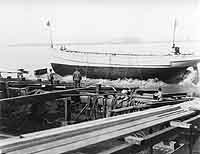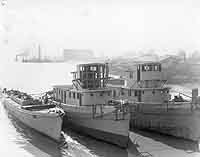Return to Naval Historical
Center home page.  Return to Online
Library listing
Return to Online
Library listing

DEPARTMENT OF THE NAVY -- NAVAL HISTORICAL CENTER
805 KIDDER BREESE SE -- WASHINGTON NAVY YARD
WASHINGTON DC 20374-5060

Online Library of Selected Images:
-- U.S. NAVY SHIPS --
U. S. Navy Harbor Tug No. 49 (classified YT-49 in 1920),
1920-1925.
Harbor Tug No. 49, a 215-ton, 88-foot long wooden-hulled
tug propelled by a single-cylinder steam engine, was built by
the Industrial Department of the U. S. Naval Station, New Orleans,
Louisiana as one of 40 sisters (Harbor Tugs Nos. 46-85) ordered
by the Navy in May and June 1918 as part of its World War I emergency
shipbuilding effort. Her keel was laid down in August 1918, she
was launched in January 1919 and commissioned in July 1920. Harbor
Tug No. 49 was classified YT-49 when the Navy implemented
its standard hull classification system in July 1920. In February
1921 the Commandant, Fourteenth Naval District, requested that
two additional motor tugs of the YT-86 class be sent to Pearl
Harbor as soon as possible. However, none was available and in
March 1921 the steam-propelled Harbor Tug No. 49 and Harbor Tug No. 50, both still at New Orleans,
were substituted. They were towed to the Canal Zone, and from
there to Mare Island, California, by USS Kingfisher (AM-25)
in August 1921. During September and October the two tugs were
towed from Mare Island to Pearl Harbor by USS Ontario (AT-13).
In March 1922, as part of a reduction in district personnel
and district craft at Pearl Harbor, the office of the Chief of
Naval Operations ordered Harbor Tugs Nos. 49 and 50
placed out of commission "with a view to recommissioning
at some later date". Harbor Tug No. 49 was decommissioned
in August 1922. In July 1924 an inspection board found her to
be unfit for further Naval service, and in December the Chief
of Naval Operations struck her and Harbor Tug No. 50 from
the Navy list and placed them on the list of ships to be sold,
with the comment that "this type of wooden harbor tug has
been found to be unsuitable for Navy use." The two tugs were
sold together in September 1925. When the Navy Department asked
the Commandant, Fourteenth Naval District why they had been sold
for a quarter of their appraised value, the Commandant explained
that the two tugs were useless for Government service at Pearl
Harbor because their steaming radius was very small, their steam
engines were of the noncondensing type (which required frequent
replenishments of fresh water), and their hand-reversing gear
was dangerous to operate when the engine stuck on top or bottom
dead center (a common occurrence with single-cylinder steam engines).
Finally, the hulls and fresh water tanks of the tugs were of war-time
wooden construction and would need costly repairs to be made serviceable.
This page features all the views we have concerning U.S.
Navy Harbor Tug No. 49 (later YT-49).
Click on the small photograph to prompt
a larger view of the same image.
Photo #: NH 41611
U. S. Navy Harbor Tugs and Submarine Chasers
The 88-foot Harbor Tug No. 48 (on the right), Harbor
Tug No. 49, and the 110-foot Submarine Chaser No. 443
being fitted out by the Industrial Department of the U. S. Naval
Station, New Orleans, La., in early 1919. Harbor Tug No. 50
and Submarine Chaser No. 444 are in the building ways
in the background. The center building way, from which Harbor
Tug No. 49 was probably launched, is empty.
Official U.S. Navy Photograph, from the collections of the
Naval Historical Center.
Online Image: 54KB; 740 x 605 pixels |
 |
Photo #: NH 41610
U. S. Navy 88-foot Harbor Tugs
Under construction by the Industrial Department of the U. S.
Naval Station, New Orleans, La. with two 110-foot submarine chasers,
probably between August 1918 and January 1919. The vessels are
probably, from left to right, Submarine Chaser No. 443
with Submarine Chaser No. 444 to port, Harbor Tug No.
49, and Harbor Tug No. 50.
Official U.S. Navy Photograph, from the collections of the
Naval Historical Center.
Online Image: 55KB; 740 x 605 pixels |
 |
Photo #: NH 41615
U. S. Navy 88-foot Harbor Tug
Under construction by the Industrial Department of the U. S.
Naval Station, New Orleans, La., probably between August 1918
and January 1919. This is probably Harbor Tug No. 50,
with Harbor Tug No. 49 partly visible behind the shed
to the right in a more advanced stage of construction.
Official U.S. Navy Photograph, from the collections of the
Naval Historical Center.
Online Image: 63KB; 740 x 605 pixels |
 |
Photo #: NH 41612
U. S. Navy 88-foot Harbor Tug
Being launched by the Industrial Department of the U. S. Naval
Station, New Orleans, La. This is probably Harbor Tug No.
49 sliding down the center side-launch building way at this
yard on 19 January 1919.
Official U.S. Navy Photograph, from the collections of the
Naval Historical Center.
Online Image: 64KB; 740 x 595 pixels |
 |
Photo #: NH 41613
U. S. Navy 88-foot Harbor Tug
The steam engine for one of the three small tugs (Harbor Tugs
Nos. 48-50) built by the Industrial Department of the U.
S. Naval Station, New Orleans, La., in 1918-1920.
It is a vertical, single-cylinder, non-condensing engine with
a cylinder diameter of 18 inches and stroke of 22 inches and
was rated at 300 horsepower.
Official U.S. Navy Photograph, from the collections of the
Naval Historical Center.
Online Image: 85KB; 585 x 765 pixels |
 |
Photo #: NH 104706
U. S. Navy "Wood Harbor Tug"
Outboard profile of the Harbor Tug No. 46 class (Nos 46
through 85). This plan by the Navy's Bureau of Construction and
Repair is dated 25 April 1919 and is signed by the bureau's chief,
Naval Constructor David W. Taylor, USN. Its number is C&R No.
60815.
These tugs measured 88 feet in length and 20 feet in beam, displaced
215 tons, and had a designed speed of 10 knots.
U.S. Naval Historical Center Photograph.
Online Image: 59KB; 740 x 435 pixels |
 |
 Return to Naval
Historical Center home page.
Return to Naval
Historical Center home page.
Page made 30 April 2007
